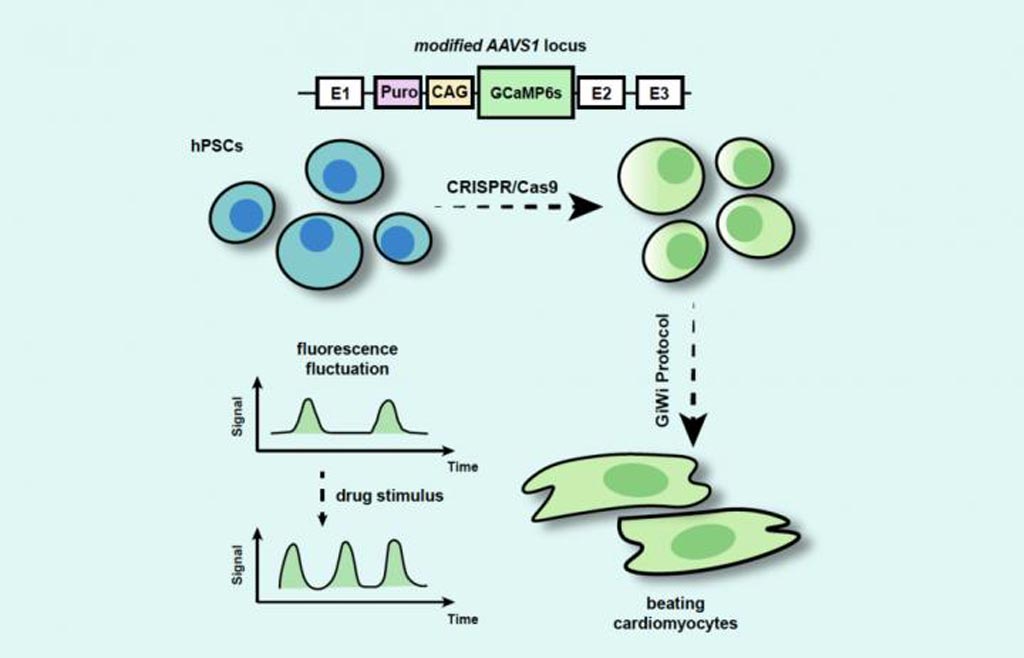Tracer Cardiomyocytes Generated by Stem Cell Modification
By LabMedica International staff writers
Posted on 03 Jan 2019
The CRISPR/Cas9 genome-editing tool was used as part of a process designed to produce fluorescent-labeled cardiomyocytes (CMs) from human pluripotent stem cells (hPSCs).Posted on 03 Jan 2019
CRISPR/Cas9 is regarded as the cutting edge of molecular biology technology. CRISPRs (clustered regularly interspaced short palindromic repeats) are segments of prokaryotic DNA containing short repetitions of base sequences. Each repetition is followed by short segments of "spacer DNA" from previous exposures to a bacterial virus or plasmid. Since 2013, the CRISPR/Cas9 system has been used in research for gene editing (adding, disrupting, or changing the sequence of specific genes) and gene regulation. By delivering the Cas9 enzyme and appropriate guide RNAs (sgRNAs) into a cell, the organism's genome can be cut at any desired location. The conventional CRISPR/Cas9 system from Streptococcus pyogenes is composed of two parts: the Cas9 enzyme, which cleaves the DNA molecule and specific RNA guides that shepherd the Cas9 protein to the target gene on a DNA strand.

Image: A diagram of the process by which a fluorescent-labeled stem cell line was generated for production of cardiac cells (Photo courtesy of Pennsylvania State University).
To bring human pluripotent stem cell (hPSC)-derived cardiomyocytes (CMs) to the clinic, it is critical to evaluate the functionality of CMs. Current methods for determining functionality include using a force transducer, which analyzes the mechanics of a single muscle cell, and using calcium imaging. However, these methods cause undesirable impacts on the cells' functionality and are expensive and time-consuming.
Investigators at Pennsylvania State University (University Park, USA) reported in the November 30, 2018, online edition of the journal iScience that they had developed a process that was non-invasive and less likely to adversely affect the functionality of the CMs.
The investigators utilized the CRISPR/Cas9 gene editor to insert the ultrasensitive calcium indicator protein GCaMP6s into stem cells. The GCaMP6 protein enabled the stems cells to be induced to mature into CMs that could be directly characterized by fluorescence intensity. The intensity of the fluorescence correlated with mechanical strain detected by video microscope analysis.
The "knockin" cell line generated by CRISPR/Cas9 modification constitutively expressed GCaMP6s. This clone maintained pluripotency and cardiac differentiation potential, and these knockin hPSC-derived CMs exhibited sensitive fluorescence fluctuation with spontaneous contraction.
The knockin hPSC-derived CMs also showed sensitive response to isoprenaline treatment in a concentration-dependent manner. Thus, the GCaMP6s knockin hPSC line provided a non-invasive, sensitive, and economic approach to characterize the functionality of hPSC-derived CMs.
"CMs derived from hPSCs hold tremendous promise for cell-based therapies for heart diseases," said senior author Dr. Xiaojun Lance Lian, assistant professor of biomedical engineering at Pennsylvania State University. "Nevertheless, current methods for CM characterization cause undesirable impacts on the cells' functionality and are expensive and time-consuming. And because of the many benefits of the [CRISPR/Cas9] system, the process can further contribute to improved disease modeling and drug screening for treating cardiac diseases."
Related Links:
Pennsylvania State University














